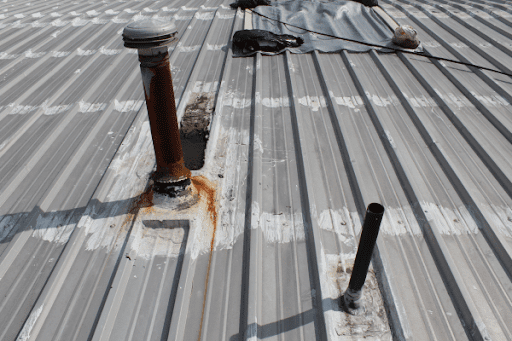A metal roof is a critical part of your building, providing protection and durability over decades. However, like any structure, even the best metal roofs can experience wear and tear from age and environmental stress. Retrofitting is a smart, cost-effective way to enhance your roof’s performance without the need for a complete replacement.
Companies like Butler Manufacturing have led the way in developing innovative solutions for retrofitting, offering systems that improve efficiency, sustainability, and durability.
Here’s how to identify when your roof needs retrofitting and how advancements in retrofit technology can address these issues.
Signs It’s Time to Retrofit Your Metal Roof
- Recurring Leaks and Water Intrusion
Leaks are often the first warning sign that a roof is no longer performing as it should. Worn-out fasteners, failing seams, or rusted panels can allow water to seep into your building, leading to interior damage and mold growth.
Retrofitting with modern systems can resolve these issues. For instance, Butler’s Metal-Over-Metal System is designed to install a new roof over the existing one without requiring a full tear-off. This system integrates advanced features like the MR-24® roof panels, which use a Pittsburgh double-lock seam to create a weathertight seal and prevent leaks. With over 2 billion square feet of MR-24 installed worldwide, its performance is proven.
- Inadequate Drainage or Ponding Water
Flat or low-slope roofs are particularly prone to ponding, where water collects and doesn’t drain properly. This adds unnecessary stress to the structure and accelerates wear, leading to leaks and water damage.
Butler’s Slope Build-Up System addresses this by adding a slope to flat roofs. This solution eliminates ponding issues and improves drainage, extending the life of the roof. The system can also accommodate added insulation to boost energy efficiency, making it a practical upgrade for older buildings.
- Corrosion or Structural Weakness
Exposure to harsh weather over the years can lead to rust, corrosion, and structural weakening in metal roofs. This not only impacts the appearance but also reduces the roof’s ability to protect the building.
Retrofitting can reinforce your roof using advanced, corrosion-resistant materials. For example, Butler’s systems use stainless steel components that are 35% stronger than traditional carbon steel. These materials ensure long-term durability even in challenging environments.
- Rising Energy Costs
Older roofs often lack proper insulation, leading to rising energy bills as heating and cooling systems work harder to maintain indoor temperatures.
Retrofitting provides an opportunity to add modern insulation materials. Butler systems allow for the integration of blanket or rigid insulation during retrofits, increasing the roof’s thermal performance. By improving the building envelope, these upgrades can reduce energy consumption and align with sustainability goals.
- Your Roof is Nearing Its Lifespan
Metal roofs typically last 20 to 40 years, but environmental factors like extreme weather can shorten this lifespan. If your roof is nearing the end of its expected service life, retrofitting can help extend it significantly without the expense of a full replacement.
Why Consider Butler’s Retrofit Solutions?
Butler has been a leader in metal roof innovation for over 100 years, creating systems designed for efficiency and durability. Here’s how their retrofit solutions stand out:
Metal-Over-Metal System
This system allows a new metal roof to be installed directly over an existing one, avoiding the expense and waste of tearing off the old roof.
Key Features:
- Watertight performance: The MR-24® roof’s double-lock seam design prevents leaks, even in extreme weather conditions.
- Flexibility for thermal movement: Roof clips allow panels to expand and contract with temperature changes, avoiding stress on the structure.
- Minimal disruption: Installation occurs with little interruption to daily operations, making it ideal for businesses.
Slope Build-Up System
The Slope Build-Up System transforms flat or low-slope roofs into sloped designs that efficiently shed water.
Key Features:
- Improved drainage: Eliminates ponding issues and reduces long-term maintenance needs.
- Versatility: Compatible with Butler’s MR-24® and VSR™ roof systems, offering design flexibility.
- Enhanced insulation: Provides an opportunity to add modern insulation for better energy efficiency.
The Long-Term Benefits of Retrofitting
- Cost Savings
Retrofitting eliminates the need for costly roof tear-offs and disposal. Additionally, adding insulation during the process can significantly reduce heating and cooling costs over time.
- Durability in Harsh Weather
Butler’s retrofit systems are engineered to withstand extreme weather. The MR-24 roof, for example, has been proven to resist hurricane-force winds and heavy snow loads, offering peace of mind to building owners.
- Sustainability
Retrofitting is an environmentally friendly solution. By reusing your existing roof structure, you reduce waste sent to landfills. Butler’s use of recyclable materials further enhances the sustainability of their solutions.
When to Take Action
If your roof is showing signs of leaks, ponding water, corrosion, or energy inefficiency, it’s time to consult a roofing professional. An inspection can help determine whether a retrofit is the right solution for your building. Butler’s systems offer customizable options that fit a variety of needs, ensuring your roof can meet modern performance standards.
Wrapping Up
Retrofitting your metal roof is a practical way to enhance its performance, extend its life, and save on costs. With innovative solutions like Butler’s Metal-Over-Metal and Slope Build-Up systems, you can address issues like leaks, drainage problems, and rising energy expenses—all while improving durability and sustainability.
If you’re ready to explore your retrofit options, contact a trusted roofing professional or your local Butler Builder to learn more about how these systems can transform your roof and protect your investment.


